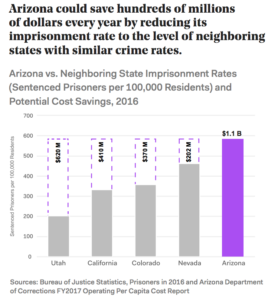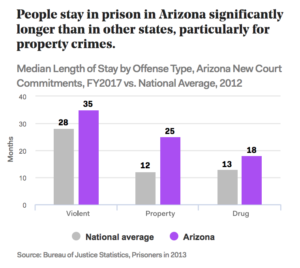WASHINGTON, DC – A new report issued today by FWD.us finds that Arizona’s prison population has continued to rise, bucking national and regional trends. This groundbreaking study finds that the state’s rapid prison growth cannot be explained by more crime or a growing resident population, but instead was driven by decisions to send more people to prison for nonviolent offenses, and to keep people in prison for far longer than the national average.
The report, “Arizona’s Imprisonment Crisis: The High Price of Prisons,” examines how Arizona reached this point and the economic impacts of Arizona’s broken criminal justice system. This unprecedented analysis finds that Arizona’s prison population is 12 times larger than it was 40 years ago, and that this growth has been driven by prison sentences for less serious offenses — 7 in 10 prison admissions are for non-violent offenses such as drug possession and 4 in 10 are for first-time felony convictions.
“Arizona’s over-imprisonment crisis is hurting the state’s economy and costing state taxpayers billions of dollars without leading to safer communities or stronger families. Arizona can be a leader on criminal justice reform by adopting common sense reforms that will reduce incarceration and improve public safety,” said Todd Schulte, President of FWD.us. “Poor policy choices created this crisis. This report aims to begin a data-driven conversation about how smart policy choices can unwind the crisis.”
Despite overwhelming evidence that states can safely reduce crime and incarceration, Arizona continues to be a national outlier, with the fourth highest imprisonment rate in the country, prison sentences significantly longer than other states, and $1.1 billion in prison spending every year. Taxpayer spending on the Department of Corrections has increased by $280 million annually since FY 2000 alone and corrections spending now exceeds other critical priorities like child safety, higher education, and social services for families.
The state could save hundreds of millions of dollars every year by reducing its imprisonment rate to the level of neighboring states with similar crime rates. If Arizona’s imprisonment rate matched Nevada’s, it would save $200 million every year. If it matched Utah’s, state taxpayers would save more than $600 million every year.

FWD.us has identified what is driving prison population growth — increased admissions for non-violent offenses and first-time felony convictions, and prison terms that are significantly longer than the national average. The number of people admitted to prison for non-violent crimes has grown by 80 percent, and the number of people sent to prison on their first felony conviction has tripled. People also stay in prison in Arizona far longer than the national average, despite research showing that there is no public safety benefit to longer prison terms. Arizona’s prison sentences for non-violent crimes are 40 to 100% longer than in other states.

FWD.us is committed to working alongside and building diverse, bipartisan coalitions of Arizonans looking for responsible, data-driven criminal justice solutions. This report covers 30 years worth of data and FWD.us analyzed almost 500,000 records trying to understand why the prison population has grown and what the cost has been to Arizona’s economy, communities, and families. It is part one of a multi-part series. Throughout the fall, FWD.us will release two additional reports that examine how Arizona’s criminal justice system hurts communities and families.
An executive summary of the report can be found here. A video explainer of the report and its findings can be found here.